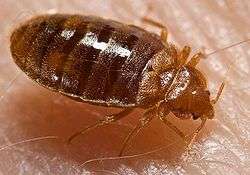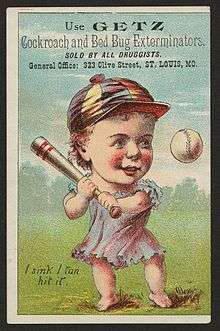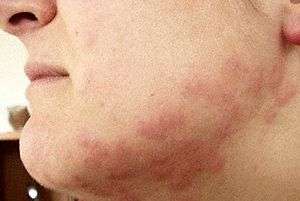Bed bug infestation
| Bed bug bites | |
|---|---|
|
Typical bed bug bites. | |
| Classification and external resources | |
| DiseasesDB | 31777 |
| MedlinePlus | 000033 |
| eMedicine | article/1088931 |
| MeSH | D001511 |
A bed bug can individually and collectively cause a number of health effects including skin rashes, psychological effects and allergic symptoms.[1] Bed bug bites or cimicosis may lead to a range of skin manifestations from no visible effects to prominent blisters.[2]:446 Diagnosis involves both finding bed bugs and the occurrence of compatible symptoms.[1] Treatment involves the elimination of the insect but is otherwise symptomatic.[1]
Because infestation of human habitats has been on the increase in developed countries, bed bug bites and related conditions have been on the rise as well, since the 1980s–1990s.[3][4] The exact causes of this resurgence remain unclear; it is variously ascribed to greater foreign travel, more frequent exchange of second-hand furnishings among homes, a greater focus on control of other pests resulting in neglect of bed bug countermeasures, and increasing resistance to pesticides.[4][5] Bed bugs have been known human parasites for thousands of years.[3]
Signs and symptoms
Skin
Individual responses to bites vary, ranging from no visible effect (in about 20–70%),[1][3] to small macular spots, to prominent wheals and bullae formations along with intense itching that may last several days.[1] The bites often occur in a line. A central hemorrhagic spot may also occur due to the release of anticoagulants in the saliva.[4]
Symptoms may not appear until some days after the bites have occurred.[1] Reactions often become more brisk after multiple bites due to possible sensitization to the salivary proteins of the bed bug.[3] The skin reaction usually occurs in the area of the bite which is most commonly the arms, shoulders and legs as they are more frequently exposed at night.[1] Numerous bites may lead to an erythematous rash or urticaria.[1]
Psychological
Serious infestations and chronic attacks can cause anxiety, stress, and insomnia.[1] Development of refractory delusional parasitosis is possible, as a person develops an overwhelming obsession with bed bugs.[6]
Other
A number of other symptoms may occur from either the bite of the bed bugs or from their exposure. Anaphylaxis from the injection of serum and other nonspecific proteins has been rarely documented.[1][7] Due to each bite taking a tiny amount of blood, chronic or severe infestation may lead to anemia.[1] Bacterial skin infection may occur due to skin break down from scratching.[1][8] Systemic poisoning may occur if the bites are numerous.[9] Exposure to bed bugs may trigger an asthma attack via the effects of airborne allergens although evidence of this association is limited.[1] There is no evidence that bed bugs transmit infectious diseases[1] even though they appear physically capable of carrying pathogens and this possibility has been investigated.[1][3] The bite itself may be painful thus resulting in poor sleep and worse work performance.[1]
Cause

Bed bug bites are caused by bed bugs primarily of two species Cimex lectularius (the common bed bug) and Cimex hemipterus.[3] Infestation is rarely due to a lack of hygiene.[10] These insects feed exclusively on blood and may survive a year without eating.[3] They are attracted by body warmth and carbon dioxide.[4] Transfer to new places is usually in the personal effects of the human they feed upon.[3]
Dwellings can become infested with bed bugs in a variety of ways, such as:
- Bugs and eggs inadvertently brought in from other infested dwellings on a visiting person's clothing or luggage;
- Infested items (such as furniture, clothing, or backpacks) brought in;
- Nearby dwellings or infested items, if easy routes are available for travel, e.g. through ducts or false ceilings;
- Wild animals (such as bats or birds)[11][12] that may also harbour bed bugs or related species such as the bat bug;
- People visiting an infested area (e.g. dwelling, means of transport, entertainment venue, or lodging) and carrying the bugs to another area on their clothing, luggage, or bodies. Bedbugs are increasingly found in air travel.[13]
- Though bed bugs will feed on pets, they do not live or travel on the skin of their hosts, and pets are not believed a factor in their spread.[14]
Diagnosis
A definitive diagnosis of health effects due to bed bugs requires a search for and finding of the insect in the sleeping environment as symptoms are not sufficiently specific.[1] Other possible conditions with which these conditions can be confused include scabies, allergic reactions, mosquito bites, spider bites, chicken pox and bacterial skin infections.[1] Bed bugs classically form a line of bites colloquially referred to as "breakfast, lunch, and dinner" and rarely feed in the armpit or behind the knee which may help differentiate it from other biting insects.[4] If the number in a house is large a pungent sweet odor may be described.[4]
Treatment
Treatment requires keeping the person from being repeatedly bitten and possible symptomatic use of antihistamines and corticosteroids (either topically or systemically).[1] There however is no evidence that medications improve outcomes and symptoms usually resolve without treatment in 1–2 weeks.[3][4]
Avoiding repeated bites can be difficult, since it usually requires eradicating bed bugs from a home or workplace; eradication frequently requires a combination of pesticide and non pesticide approaches.[3] Pesticides that have historically been found to be effective include pyrethroids, dichlorvos and malathion.[4] Resistance to pesticides has increased significantly over time and there are concerns of negative health effects from their usage.[3] Mechanical approaches such as vacuuming up the insects and heat treating or wrapping mattresses have been recommended.[3]
Epidemiology
Bed bugs occur around the world.[15] Rates of infestations in developed countries, while decreasing from the 1930s to the 1980s, have increased dramatically since the 1980s.[3][4][15] Previous to this they were common in the developing world but rare in the developed world.[4] The increase in the developed world may have been caused by increased international travel, resistance to insecticides, and the use of new pest-control methods that do not affect bed bugs.[5][16] The fall in bed bug populations after the 1930s in the developed world is believed to be partly due to the usage of DDT to kill cockroaches.[17] The invention of the vacuum cleaner and simplification of furniture design may have also played a role.[17] Others believe it might simply be the cyclical nature of the organism.[18]
History

Bed bugs have been known to be a human parasite for thousands of years and many different methods have been attempted to deal with them.[3]
Plants traditionally used as bed bug repellents include black cohosh (Actaea racemosa), Pseudarthria hookeri, and Laggera alata (Chinese yángmáo cǎo | 羊毛草), though information about their effectiveness is lacking.[19] Eucalyptus saligna oil was reported by some Zairean researchers to kill bed bugs, among other insects.[20][21]
In the 18th century, turpentine was used in combination with henna (Lawsonia inermis) flowers and alcohol, as an insecticide that also reputedly killed bed bug eggs.[22]
Other items that were believed to kill bed bugs in the early 19th century include "infused oil of Melolontha vulgaris" (presumably a kind of cockchafer), fly agaric (Amanita muscaria), Actaea spp. (e.g. black cohosh), tobacco, "heated oil of Terebinthina" (i.e. true turpentine), wild mint (Mentha arvensis), narrow-leaved pepperwort (Lepidium ruderale), Myrica spp. (e.g. bayberry), Robert Geranium (Geranium robertianum), bugbane (Cimicifuga spp.), "herb and seeds of Cannabis", "Opulus" berries (possibly a kind of maple, or European cranberrybush), masked hunter bugs (Reduvius personatus), "and many others."[23] In the mid-19th century, smoke from peat fires was recommended.[24]
The use of black pepper to repel bed bugs is attested in George Orwell's 1933 non-fiction book Down and Out in Paris and London.
Dusts have been used to ward off insects from grain storage for centuries, including "plant ash, lime, dolomite, certain types of soil, and diatomaceous earth (DE) or Kieselguhr".[25] Of these, diatomaceous earth in particular has seen a revival as a non-toxic (when in amorphous form) residual pesticide for bed bug abatement. Insects exposed to diatomaceous earth may take several days to die.[25]
Basket-work panels were put around beds and shaken out in the morning, in the UK and in France in the 19th century. Scattering leaves of plants with microscopic hooked hairs around a bed at night, then sweeping them up in the morning and burning them, was a technique reportedly used in Southern Rhodesia and in the Balkans.[26]
Society and culture
The rise in infestations has been hard to track because bed bugs are not an easily identifiable problem. Most of the reports are collected from pest-control companies, local authorities, and hotel chains.[27] Therefore, the problem may be more severe than is currently believed.[28]
Bed bugs are an increasing cause for litigation.[29] Courts have, in some cases, exacted large punitive damage judgments on some hotels.[30][31][32] Many of Manhattan's Upper East Side home owners have been afflicted, but they tend to be silent publicly in order not to ruin their property values and be seen as suffering a blight typically associated with the lower classes.[33]
References
- 1 2 3 4 5 6 7 8 9 10 11 12 13 14 15 16 17 18 19 Doggett SL, Russell R (November 2009). "Bed bugs – What the GP needs to know". Aust Fam Physician. 38 (11): 880–4. PMID 19893834.
- ↑ James, William D.; Berger, Timothy G.; et al. (2006). Andrews' Diseases of the Skin: clinical Dermatology. Saunders Elsevier. ISBN 0-7216-2921-0.
- 1 2 3 4 5 6 7 8 9 10 11 12 13 14 Jerome Goddard; Richard deShazo (2009). "Bed bugs (Cimex lectularius) and clinical consequences of their bites". Journal of the American Medical Association. 301 (13): 1358–1366. doi:10.1001/jama.2009.405. PMID 19336711.
- 1 2 3 4 5 6 7 8 9 10 Kolb A, Needham GR, Neyman KM, High WA (2009). "Bedbugs". Dermatol Ther. 22 (4): 347–52. doi:10.1111/j.1529-8019.2009.01246.x. PMID 19580578.
- 1 2 A Romero; MF Potter; DA Potter; KF Haynes (2007). "Insecticide Resistance in the Bed Bug: A Factor in the Pest's Sudden Resurgence?" (PDF). Journal of medical entomology. 22 (2): 175–178. doi:10.1603/0022-2585(2007)44[175:IRITBB]2.0.CO;2. Retrieved 2010-09-17.
- ↑ Susan C. Jones (January 2004). "Extension Fact Sheet "Bed Bugs, Injury"" (PDF). Ohio State University.
- ↑ Bircher, Andreas J (2005). "Systemic Immediate Allergic Reactions to Arthropod Stings and Bites". Dermatology. Blackwell Publishing. 210 (2): 119–127. doi:10.1159/000082567. PMID 15724094.
- ↑ "How to Manage Pests Pests of Homes, Structures, People, and Pets". UC IPM Online (Statewide Integrated Pest Management Program, UC Davis). Retrieved 26 June 2010.
- ↑ Encyclopedia Americana, 1996 ed., v. 3, p. 431
- ↑ Hildreth CJ, Burke AE, Glass RM (April 2009). "JAMA patient page. Bed bugs". JAMA. 301 (13): 1398. doi:10.1001/jama.301.13.1398. PMID 19336718.
- ↑ Potter, Michael F. "BED BUGS". University of Kentucky College of Agriculture. Archived from the original on 2 July 2010. Retrieved 27 June 2010.
- ↑ Steelman, C.D. 2000. Biology and control of bed bugs, Cimex lectularius, in poultry houses. Avian Advice 2: 10,15.
- ↑ Forbes: Bed Bugs on Airplanes?! Yikes! How to Fly Bed Bug-Free, 21 November 2011
- ↑ "The Truth About Bedbugs: Debunking the Myths". PAWS SF. Archived from the original on 2013-10-14. Retrieved 13 Oct 2013.
- 1 2 Heukelbach, J; Hengge, UR (2009). "Bed bugs, leeches and hookworm larvae in the skin". Clinics in dermatology. 27 (3): 285–90. doi:10.1016/j.clindermatol.2008.10.008. PMID 19362691.
- ↑ Owen, James (13 May 2004). "Bloodthirsty Bedbugs Stage Comeback in U.S., Europe". National Geographic News. National Geographic. Retrieved 31 May 2010.
- 1 2 Krause-Parello CA, Sciscione P (April 2009). "Bedbugs: an equal opportunist and cosmopolitan creature". J Sch Nurs. 25 (2): 126–32. doi:10.1177/1059840509331438. PMID 19233933.
- ↑ p.131
- ↑ IPM Practitioner, XXIX(3/4), March/April 2007 http://www.birc.org/MarApril2007.pdf
- ↑ Schaefer, C.W.; Pazzini, A.R. (28 July 2000). Heteroptera of Economic Importance. Boca Raton, FL: CRC Press. p. 525. ISBN 0849306957.
- ↑ Kambu, Kabangu; Di Phanzu, N.; Coune, Claude; Wauters, Jean-Noël; Angenot, Luc (1982). "Contribution à l'étude des propriétés insecticides et chimiques d'Eucalyptus saligna du Zaïre (Contribution to the study of insecticide and chemical properties of Eucalyptus saligna from Zaire ( Congo))". Plantes Médicinales et Phytothérapie. Paris: Jouve. 16 (1): 34–38. hdl:2268/14438.
- ↑ Rictor Norton, Early Eighteenth-Century Newspaper Reports: A Sourcebook, "Getting Rid of Bed-Bugs", 18 November 2001, updated 30 November 2001 <http://grubstreet.rictornorton.co.uk/bedbugs.htm>
- ↑ Johann Friedrich Wolff and Johann Philip Wolff, Icones Cimicum descriptionibus illustratae, fourth fascicle (1804), p. 127. https://archive.org/stream/iconescimicumdes00wolf#page/n163/mode/2up
- ↑ "Peat and peat mosses". Scientific American. 3 (39): 307. 17 June 1848. Retrieved 26 May 2010.
- 1 2 Hill, Stuart B. (May 1986). "Diatomaceous Earth: A Non Toxic Pesticide". Macdonald J. Ste-Anne de Bellevue, QC: Macdonald College. 47 (2): 14–42. Retrieved 26 May 2010.
- ↑ Boase, C. (2001). "Bedbugs – back from the brink". Pesticide Outlook. 12 (4): 159–162. doi:10.1039/b106301b. Retrieved 2010-05-27.
- ↑ Boase, Clive J. (April 2004). "Bed-bugs – reclaiming our cities". Biologist. 51: 1–4. Retrieved 2010-06-07.
- ↑ Scarupa, M.D.; Economides, A. (2006). "Bedbug bites masquerading as urticaria". Journal of Allergy and Clinical Immunology. 117 (6): 1508–1509. doi:10.1016/j.jaci.2006.03.034.
- ↑ Initi, John "Sleeping with the Enemy" Maclean's, 1/14/2008, Vol. 121, Issue 1, p54–56
- ↑ Kimberly Stevens (2003-12-25). "Sleeping with the Enemy". New York Times. Retrieved 2010-01-16.
- ↑ Judge Richard Posner (2003-10-21). "347 F.3d 672 BURL MATHIAS and DESIREE MATHIAS, Plaintiffs-Appellees/Cross-Appellants, v. ACCOR ECONOMY LODGING, INC. and MOTEL 6 OPERATING L.P., Defendants-Appellants/Cross-Appellees. UNITED STATES COURT OF APPEALS FOR THE SEVENTH CIRCUIT Nos. 03–1010, 03–1078". Retrieved 2010-01-16.
- ↑ Shavell, Steven (2007), "On the Proper Magnitude of Punitive Damages: Mathias v. Accor Economy Lodging, Inc." (PDF), Harvard Law Review, 120: 1223–1227, archived from the original (PDF) on 2008-08-27, retrieved 2010-01-16
- ↑ Marshall Sella (2010-05-02). "Bedbugs in the Duvet: An infestation on the Upper East Side". New York Magazine. Retrieved 2010-06-11.
External links
| Wikimedia Commons has media related to Bedbug bites. |
- CISR: Center for Invasive Species Research More information on Bed Bugs, with lots of photos and video
